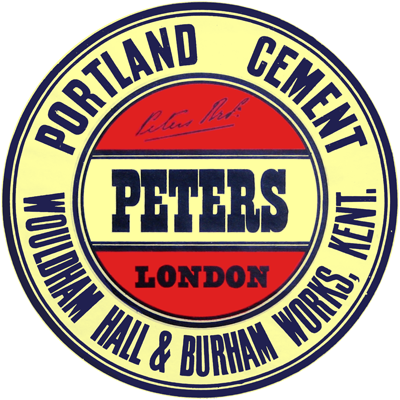
Peters Brand. Image kindly supplied by Mark Peters.
Location:
- Grid reference: TQ71186291
- x=571180
- y=162910
- 51°20'22"N; 0°27'28"E
- Civil Parish: Wouldham, Kent: the southern end of the plant, and all the lime kilns were in Burham, Kent
Clinker manufacture operational: 1870 - 1928
Approximate total clinker production: 2.5 million tonnes
Raw materials:
- Grey Chalk (Zig-zag Chalk Formation: 94-97 Ma) and Middle Chalk (Holywell Nodular Chalk Formation: 92-94 Ma) from quarry at 571800,163200
- Medway Alluvial Clay
Ownership:
- 1870-1911 Peters Brothers
- 1911-1928 BPCM (Blue Circle)
Before the BPCM acquisition, this was known as Wouldham Hall Works. Peters had been making hydraulic lime at the site, and 18 lime kilns remained throughout. Cement manufacture began with wet process bottle kilns, numbering 24 by 1879, making 720 t/week. These were replaced with Batchelor chamber kilns in the mid-1880s, still giving 720 t/week. During 1888-1889, a further nine chamber kilns were added, bringing total capacity to 990 t/week. Also during the 1890s, two 18-chamber Hoffman rings were installed, but appear to have been used only for lime. During 1898-1899, 17 more chamber kilns (510 t/week) were installed. In 1903 three Schneider kilns (330 t/week) burning surplus dryings were installed, bringing the total capacity close to Davis’ 1907 value of 1850 t/week. To install the rotary kilns, the first chamber kiln block was demolished, and the remaining chamber kilns were only used up to 1915. Most were removed, but the last six remained in commission until closure, although these were only used during 1919-1922. Operations were combined with West Kent by BPCM with only the Peters rotary kilns running right through WWI. The plant was described in detail in the BPCM 1924 schedule. There was no railway link, and the building of Holborough nearby finally squeezed the west bank plants out. After closure, the rotary kilns were moved to Crown and Quarry and Shoreham. The plant also made perhaps 50,000 tonnes a year of grey and white lime, and this may have continued for some time after the cement plant closed – the bottle and Hoffman kilns remained in place into the 1960s. The site was gradually cleared, the last buildings having been removed only recently, but much of the foundations are still visible. The quarry remains waste. See Wouldham Village website.
Power Supply
The plant was directly driven by double expansion steam engines - 550 HP for raw milling and 1000 HP for finish milling. The rotary kilns were electrically driven, using power from a small generator run from the 400 HP kiln section steam engine.
Rawmills
It seems that chalk and clay were initially milled together in a pair of washmills, then re-ground with flat-stone mills. Later, clay was washmilled separately, and the chalk was washed with clay slip in a 18' washmill followed by four 16' screening mills. In the 1920s it also supplied the West Kent kilns.
Two rotary kilns were installed:
Kiln A1
Supplier: FLS
Operated: ?11/1911 - 1928
Process: Wet
Location: hot end 571283,162749: cold end 571262,162793: hot end enclosed.
Dimensions: metric 50.00 × 2.700B / 2.400CD
Rotation (viewed from firing end): clockwise
Slope: 1/25 (2.292°)
Speed: ?
Drive: ?
Kiln profile: 0×1925: 700×1925: 700×2400: 2100×2400: 2100×2700: 9900×2700: 11925×2400: 50000×2400: Tyres at 1300, 13200, 27700, 44475
Cooler: “double-back” concentric rotary metric 10.8 × 1.500 / 1.350 / 2.100 beneath the kiln
Cooler profile: 0×1500: 4050×1500: 4050×1350: 10350×1350: 10800×2100: 4350×2100: tyre at 2700 with trunnion end bearing: turning gear at tail end.
Fuel: Coal
Coal Mill: indirect: common drier + FLS Kominor C ball mill + tube mill common to both kilns. The tube mill was later converted to combination format, and the Kominor was discarded.
Exhaust: via drop-out box to stack.
Typical Output: 119 t/d
Typical Heat Consumption: 1911-1914 9.3 MJ/kg: 1914-1928 8.1 MJ/kg
Kiln A2
Operated: ?5/1913 - 1928
Location: hot end 571288,162751: cold end 571267,162795: hot end enclosed.
Identical in all other respects to A1
Sources:
- Primary Sources:
- Greenhithe Archive
- BPCM 1924 schedule
- aerial photography
- Ordnance Survey 1:2500 mapping
- BGS mapping and monographs
- Confirmatory Sources: